Bacteriocins, Antimicrobial Peptides from Bacterial Origin: Overview of Their Biology and Their Impact against Multidrug-Resistant Bacteria
Abstract
1. Introduction
2. Classification of Bacteriocins
2.1. Bacteriocins Produced by Gram-Positive Bacteria (BGPB)
2.2. Bacteriocins Produced by Gram-Negative Bacteria (BGNB)
3. Bacteriocin Biosynthesis
3.1. Biosynthesis of BGPB
3.2. Biosynthesis of BGNB
4. Mechanism of Action
4.1. Antimicrobial Mechanisms of Bacteriocins
4.2. Self-Immunity Mechanisms
4.3. Mechanisms of Bacteriocin Resistance
5. Antimicrobial Activity against Human Pathogens
5.1. Antimicrobial Activity of BGPB
5.2. Antibacterial Activity of BGNB
6. Conclusions
Funding
Acknowledgments
Conflicts of Interest
References
- Gould, I.M. Antibiotic resistance: The perfect storm. Int. J. Antimicrob. Agents 2009, 34, S2–S5. [Google Scholar] [CrossRef]
- Xia, J.; Gao, J.; Kokudo, N.; Hasegawa, K.; Tang, W. Methicillin-resistant Staphylococcus aureus antibiotic resistance and virulence. Biosci. Trends 2013, 7, 113–121. [Google Scholar] [CrossRef][Green Version]
- Giamarellou, H.; Poulakou, G. Multidrug-Resistant Gram-Negative Infections. Drugs 2009, 69, 1879–1901. [Google Scholar] [CrossRef]
- Calfee, D.P. Methicillin-resistant Staphylococcus aureus and vancomycin-resistant enterococci, and other Gram-positives in healthcare. Curr. Opin. Infect. Dis. 2012, 25, 385. [Google Scholar] [CrossRef]
- Duval, R.E.; Grare, M.; Demoré, B. Fight Against Antimicrobial Resistance: We Always Need New Antibacterials but for Right Bacteria. Molecules 2019, 24, 3152. [Google Scholar] [CrossRef]
- Planson, A.-G.; Carbonell, P.; Grigoras, I.; Faulon, J.-L. Engineering antibiotic production and overcoming bacterial resistance. Biotechnol. J. 2011, 6, 812–825. [Google Scholar] [CrossRef]
- Butler, M.S.; Blaskovich, M.A.; Cooper, M.A. Antibiotics in the clinical pipeline in 2013. J. Antibiot. (Tokyo) 2013, 66, 571–591. [Google Scholar] [CrossRef]
- Mbaveng, A.T.; Sandjo, L.P.; Tankeo, S.B.; Ndifor, A.R.; Pantaleon, A.; Nagdjui, B.T.; Kuete, V. Antibacterial activity of nineteen selected natural products against multi-drug resistant Gram-negative phenotypes. SpringerPlus 2015, 4, 823. [Google Scholar] [CrossRef]
- Gratia, A. Sur un remarquable exemple d’antagonisme entre deux souches de coilbacille. CR Seances Soc. Biol. Fil. 1925, 93, 1040–1041. [Google Scholar]
- Akerey, B.; Le-Lay, C.; Fliss, I.; Subirade, M.; Rouabhia, M. In vitro efficacy of nisin Z against Candida albicans adhesion and transition following contact with normal human gingival cells. J. Appl. Microbiol. 2009, 107, 1298–1307. [Google Scholar] [CrossRef]
- Hassan, M.; Kjos, M.; Nes, I.F.; Diep, D.B.; Lotfipour, F. Natural antimicrobial peptides from bacteria: Characteristics and potential applications to fight against antibiotic resistance. J. Appl. Microbiol. 2012, 113, 723–736. [Google Scholar] [CrossRef] [PubMed]
- Torres, N.I.; Noll, K.S.; Xu, S.; Li, J.; Huang, Q.; Sinko, P.J.; Wachsman, M.B.; Chikindas, M.L. Safety, Formulation and In Vitro Antiviral Activity of the Antimicrobial Peptide Subtilosin Against Herpes Simplex Virus Type 1. Probiotics Antimicrob. Proteins 2013, 5, 26–35. [Google Scholar] [CrossRef] [PubMed]
- Park, S.-C.; Park, Y.; Hahm, K.-S. The Role of Antimicrobial Peptides in Preventing Multidrug-Resistant Bacterial Infections and Biofilm Formation. Int. J. Mol. Sci. 2011, 12, 5971–5992. [Google Scholar] [CrossRef] [PubMed]
- Yasir, M.; Willcox, M.D.P.; Dutta, D. Action of Antimicrobial Peptides against Bacterial Biofilms. Materials 2018, 11, 2468. [Google Scholar] [CrossRef]
- Cascales, E.; Buchanan, S.K.; Duché, D.; Kleanthous, C.; Lloubès, R.; Postle, K.; Riley, M.; Slatin, S.; Cavard, D. Colicin Biology. Microbiol. Mol. Biol. Rev. 2007, 71, 158–229. [Google Scholar] [CrossRef]
- Martínez, B.; Rodríguez, A.; Suárez, E. Antimicrobial Peptides Produced by Bacteria: The Bacteriocins. In New Weapons to Control Bacterial Growth; Villa, T.G., Vinas, M., Eds.; Springer International Publishing: Cham, Switzerland, 2016; pp. 15–38. ISBN 978-3-319-28368-5. [Google Scholar] [CrossRef]
- Cotter, P.D.; Ross, R.P.; Hill, C. Bacteriocins—A viable alternative to antibiotics? Nat. Rev. Microbiol. 2013, 11, 95–105. [Google Scholar] [CrossRef]
- Heng, N.C.K.; Wescombe, P.A.; Burton, J.P.; Jack, R.W.; Tagg, J.R. The Diversity of Bacteriocins in Gram-Positive Bacteria. In Bacteriocins: Ecology and Evolution; Riley, M.A., Chavan, M.A., Eds.; Springer Berlin Heidelberg: Berlin/Heidelberg, Gertmany, 2007; pp. 45–92. ISBN 978-3-540-36604-1. [Google Scholar] [CrossRef]
- Perez, R.H.; Zendo, T.; Sonomoto, K. Novel bacteriocins from lactic acid bacteria (LAB): Various structures and applications. Microb. Cell Factories 2014, 13, S3. [Google Scholar] [CrossRef]
- Yang, S.-C.; Lin, C.-H.; Sung, C.T.; Fang, J.-Y. Antibacterial activities of bacteriocins: Application in foods and pharmaceuticals. Front. Microbiol. 2014, 5, 241. [Google Scholar] [CrossRef]
- Kleinkauf, H.; von Döhren, H. Review Nonribosomal biosynthesis of peptide antibiotics. In EJB Reviews 1990; Christen, P., Hofmann, E., Eds.; European Journal of Biochemistry; Springer: Berlin/Heidelberg, Germany, 1991; pp. 151–165. ISBN 978-3-642-76168-3. [Google Scholar] [CrossRef]
- Jack, R.W.; Tagg, J.R.; Ray, B. Bacteriocins of gram-positive bacteria. Microbiol. Mol. Biol. Rev. 1995, 59, 171–200. [Google Scholar] [CrossRef]
- Chavan, M.A.; Riley, M.A. Molecular Evolution of Bacteriocins in Gram-Negative Bacteria. In Bacteriocins: Ecology and Evolution; Riley, M.A., Chavan, M.A., Eds.; Springer: Berlin/Heidelberg, Germany, 2007; pp. 19–43. ISBN 978-3-540-36604-1. [Google Scholar] [CrossRef]
- Klaenhammer, T.R. Bacteriocins of lactic acid bacteria. Biochimie 1988, 70, 337–349. [Google Scholar] [CrossRef]
- O’Connor, P.M.; O’Shea, E.F.; Guinane, C.M.; O’Sullivan, O.; Cotter, P.D.; Ross, R.P.; Hill, C. Nisin H Is a New Nisin Variant Produced by the Gut-Derived Strain Streptococcus hyointestinalis DPC6484. Appl. Environ. Microbiol. 2015, 81, 3953–3960. [Google Scholar] [CrossRef]
- Majeed, H.; Lampert, A.; Ghazaryan, L.; Gillor, O. The Weak Shall Inherit: Bacteriocin-Mediated Interactions in Bacterial Populations. PLoS ONE 2013, 8, e63837. [Google Scholar] [CrossRef]
- Cintas, L.M.; Casaus, M.P.; Herranz, C.; Nes, I.F.; Hernández, P.E. Review: Bacteriocins of Lactic Acid Bacteria. Food Sci. Technol. Int. 2001, 7, 281–305. [Google Scholar] [CrossRef]
- Balciunas, E.M.; Castillo Martinez, F.A.; Todorov, S.D.; de Melo Franco, B.D.G.; Converti, A.; de Souza Oliveira, R.P. Novel biotechnological applications of bacteriocins: A review. Food Control 2013, 32, 134–142. [Google Scholar] [CrossRef]
- Deegan, L.H.; Cotter, P.D.; Hill, C.; Ross, P. Bacteriocins: Biological tools for bio-preservation and shelf-life extension. Int. Dairy J. 2006, 16, 1058–1071. [Google Scholar] [CrossRef]
- Zacharof, M.P.; Lovitt, R.W. Bacteriocins Produced by Lactic Acid Bacteria a Review Article. APCBEE Procedia 2012, 2, 50–56. [Google Scholar] [CrossRef]
- Abee, T.; Krockel, L.; Hill, C. Bacteriocins: Modes of action and potentials in food preservation and control of food poisoning. Int. J. Food Microbiol. 1995, 28, 169–185. [Google Scholar] [CrossRef]
- Ahmad, V.; Khan, M.S.; Jamal, Q.M.S.; Alzohairy, M.A.; Al Karaawi, M.A.; Siddiqui, M.U. Antimicrobial potential of bacteriocins: In therapy, agriculture and food preservation. Int. J. Antimicrob. Agents 2017, 49, 1–11. [Google Scholar] [CrossRef]
- Barbosa, A.A.T.; Mantovani, H.C.; Jain, S. Bacteriocins from lactic acid bacteria and their potential in the preservation of fruit products. Crit. Rev. Biotechnol. 2017, 37, 852–864. [Google Scholar] [CrossRef]
- Rea, M.C.; Sit, C.S.; Clayton, E.; O’Connor, P.M.; Whittal, R.M.; Zheng, J.; Vederas, J.C.; Ross, R.P.; Hill, C. Thuricin CD, a posttranslationally modified bacteriocin with a narrow spectrum of activity against Clostridium difficile. Proc. Natl. Acad. Sci. USA 2010, 107, 9352–9357. [Google Scholar] [CrossRef]
- Molloy, E.M.; Ross, R.P.; Hill, C. ‘Bac’ to the future: Bioengineering lantibiotics for designer purposes. Biochem. Soc. Trans. 2012, 40, 1492–1497. [Google Scholar] [CrossRef]
- Settanni, L.; Corsetti, A. Application of bacteriocins in vegetable food biopreservation. Int. J. Food Microbiol. 2008, 121, 123–138. [Google Scholar] [CrossRef]
- Santos, J.C.P.; Sousa, R.C.S.; Otoni, C.G.; Moraes, A.R.F.; Souza, V.G.L.; Medeiros, E.A.A.; Espitia, P.J.P.; Pires, A.C.S.; Coimbra, J.S.R.; Soares, N.F.F. Nisin and other antimicrobial peptides: Production, mechanisms of action, and application in active food packaging. Innov. Food Sci. Emerg. Technol. 2018, 48, 179–194. [Google Scholar] [CrossRef]
- Chen, H.; Hoover, D.G. Bacteriocins and their Food Applications. Compr. Rev. Food Sci. Food Saf. 2003, 2, 82–100. [Google Scholar] [CrossRef]
- Beshkova, D.; Frengova, G. Bacteriocins from lactic acid bacteria: Microorganisms of potential biotechnological importance for the dairy industry. Eng. Life Sci. 2012, 12, 419–432. [Google Scholar] [CrossRef]
- Singh, N.; Abraham, J. Ribosomally synthesized peptides from natural sources. J. Antibiot. (Tokyo) 2014, 67, 277–289. [Google Scholar] [CrossRef]
- Michael, C.A.; Dominey-Howes, D.; Labbate, M. The Antimicrobial Resistance Crisis: Causes, Consequences, and Management. Front. Public Health 2014, 2, 145. [Google Scholar] [CrossRef]
- Bush, K.; Courvalin, P.; Dantas, G.; Davies, J.; Eisenstein, B.; Huovinen, P.; Jacoby, G.A.; Kishony, R.; Kreiswirth, B.N.; Kutter, E.; et al. Tackling antibiotic resistance. Nat. Rev. Microbiol. 2011, 9, 894–896. [Google Scholar] [CrossRef]
- Freire-Moran, L.; Aronsson, B.; Manz, C.; Gyssens, I.C.; So, A.D.; Monnet, D.L.; Cars, O. Critical shortage of new antibiotics in development against multidrug-resistant bacteria—Time to react is now. Drug Resist. Updat. 2011, 14, 118–124. [Google Scholar] [CrossRef]
- Toussaint, K.A.; Gallagher, J.C. β-Lactam/β-Lactamase Inhibitor Combinations: From Then to Now. Ann. Pharmacother. 2015, 49, 86–98. [Google Scholar] [CrossRef]
- Allen, H.K.; Trachsel, J.; Looft, T.; Casey, T.A. Finding alternatives to antibiotics. Ann. N. Y. Acad. Sci. 2014, 1323, 91–100. [Google Scholar] [CrossRef]
- Wang, G.; Li, X.; Wang, Z. APD3: The antimicrobial peptide database as a tool for research and education. Nucleic Acids Res. 2016, 44, D1087–D1093. [Google Scholar] [CrossRef]
- Nishie, M.; Nagao, J.-I.; Sonomoto, K. Antibacterial Peptides “Bacteriocins”: An Overview of Their Diverse Characteristics and Applications. Biocontrol Sci. 2012, 17, 1–16. [Google Scholar] [CrossRef]
- Savadogo, A.; Ouattara, A.C.; Bassole, H.I.; Traore, S.A. Bacteriocins and lactic acid bacteria—A minireview. Afr. J. Biotechnol. 2006, 5. [Google Scholar]
- Bierbaum, G.; Sahl, H.-G. Lantibiotics: Mode of Action, Biosynthesis and Bioengineering. Curr. Pharm. Biotechnol. 2009, 10, 218. [Google Scholar] [CrossRef]
- Fimland, G.; Johnsen, L.; Dalhus, B.; Nissen-Meyer, J. Pediocin-like antimicrobial peptides (class IIa bacteriocins) and their immunity proteins: Biosynthesis, structure, and mode of action. J. Pept. Sci. Off. Publ. Eur. Pept. Soc. 2005, 11, 688–696. [Google Scholar] [CrossRef]
- Oscáriz, J.C.; Pisabarro, A.G. Classification and mode of action of membrane-active bacteriocins produced by gram-positive bacteria. Int. Microbiol. Off. J. Span. Soc. Microbiol. 2001, 4, 13–19. [Google Scholar] [CrossRef]
- Green, G.; Dicks, L.M.T.; Bruggeman, G.; Vandamme, E.J.; Chikindas, M.L. Pediocin PD-1, a bactericidal antimicrobial peptide from Pediococcus damnosus NCFB 1832. J. Appl. Microbiol. 1997, 83, 127–132. [Google Scholar] [CrossRef]
- Devi, S.M.; Halami, P.M. Detection and Characterization of Pediocin PA-1/AcH like Bacteriocin Producing Lactic Acid Bacteria. Curr. Microbiol. 2011, 63, 181–185. [Google Scholar] [CrossRef]
- Héchard, Y.; Sahl, H.-G. Mode of action of modified and unmodified bacteriocins from Gram-positive bacteria. Biochimie 2002, 84, 545–557. [Google Scholar] [CrossRef]
- Joerger, M.C.; Klaenhammer, T.R. Characterization and purification of helveticin J and evidence for a chromosomally determined bacteriocin produced by Lactobacillus helveticus 481. J. Bacteriol. 1986, 167, 439–446. [Google Scholar] [CrossRef] [PubMed]
- Vaughan, E.E.; Daly, C.; Fitzgerald, G.F. Identification and characterization of helveticin V-1829, a bacteriocin produced by Lactobacillus helveticus 1829. J. Appl. Bacteriol. 1992, 73, 299–308. [Google Scholar] [CrossRef] [PubMed]
- da Silva Sabo, S.; Vitolo, M.; González, J.M.D.; de Souza Oliveira, R.P. Overview of Lactobacillus plantarum as a promising bacteriocin producer among lactic acid bacteria. Food Res. Int. 2014, 64, 527–536. [Google Scholar] [CrossRef] [PubMed]
- Riley, M.A. Bacteriocins, biology, ecology, and evolution. In Encyclopedia of Microbiology; Elsevier: Amsterdam, The Netherlands, 2009; pp. 32–44. [Google Scholar]
- Gillor, O.; Kirkup, B.C.; Riley, M.A. Colicins and microcins: The next generation antimicrobials. Adv. Appl. Microbiol. 2004, 54, 129–146. [Google Scholar] [CrossRef]
- Bakkal, S.; Robinson, S.M.; Ordonez, C.L.; Waltz, D.A.; Riley, M.A. Role of bacteriocins in mediating interactions of bacterial isolates taken from cystic fibrosis patients. Microbiology 2010, 156, 2058–2067. [Google Scholar] [CrossRef][Green Version]
- Michel-Briand, Y.; Baysse, C. The pyocins of Pseudomonas aeruginosa. Biochimie 2002, 84, 499–510. [Google Scholar] [CrossRef]
- Duquesne, S.; Destoumieux-Garzón, D.; Peduzzi, J.; Rebuffat, S. Microcins, gene-encoded antibacterial peptides from enterobacteria. Nat. Prod. Rep. 2007, 24, 708–734. [Google Scholar] [CrossRef]
- Scholl, D. Phage Tail-Like Bacteriocins. Annu. Rev. Virol. 2017, 4, 453–467. [Google Scholar] [CrossRef]
- Daw, M.A.; Falkiner, F.R. Bacteriocins: Nature, function and structure. Micron 1996, 27, 467–479. [Google Scholar] [CrossRef]
- Nakayama, K.; Takashima, K.; Ishihara, H.; Shinomiya, T.; Kageyama, M.; Kanaya, S.; Ohnishi, M.; Murata, T.; Mori, H.; Hayashi, T. The R-type pyocin of Pseudomonas aeruginosa is related to P2 phage, and the F-type is related to lambda phage. Mol. Microbiol. 2000, 38, 213–231. [Google Scholar] [CrossRef]
- Chakicherla, A.; Hansen, J.N. Role of the Leader and Structural Regions of Prelantibiotic Peptides as Assessed by Expressing Nisin-Subtilin Chimeras in Bacillus subtilis 168, and Characterization of their Physical, Chemical, and Antimicrobial Properties. J. Biol. Chem. 1995, 270, 23533–23539. [Google Scholar] [CrossRef]
- Kleerebezem, M.; Quadri, L.E. Peptide pheromone-dependent regulation of antimicrobial peptide production in Gram-positive bacteria: A case of multicellular behavior. Peptides 2001, 22, 1579–1596. [Google Scholar] [CrossRef]
- Peschel, A.; Augustin, J.; Kupke, T.; Stevanovic, S.; Götz, F. Regulation of epidermin biosynthetic genes by EpiQ. Mol. Microbiol. 1993, 9, 31–39. [Google Scholar] [CrossRef]
- Moreno, F.; San Millan, J.; Hernandez-Chico, C.; Kolter, R. Microcins. Biotechnology 1995, 28, 307–321. [Google Scholar] [CrossRef]
- Pons, A.-M.; Lanneluc, I.; Cottenceau, G.; Sable, S. New developments in non-post translationally modified microcins. Biochimie 2002, 84, 531–537. [Google Scholar] [CrossRef]
- Severinov, K.; Nair, S.K. Microcin C: Biosynthesis and mechanisms of bacterial resistance. Future Microbiol. 2012, 7, 281–289. [Google Scholar] [CrossRef]
- Garrido, M.C.; Herrero, M.; Kolter, R.; Moreno, F. The export of the DNA replication inhibitor Microcin B17 provides immunity for the host cell. EMBO J. 1988, 7, 1853–1862. [Google Scholar] [CrossRef]
- Pan, S.J.; Rajniak, J.; Cheung, W.L.; Link, A.J. Construction of a Single Polypeptide that Matures and Exports the Lasso Peptide Microcin J25. ChemBioChem 2012, 13, 367–370. [Google Scholar] [CrossRef]
- Delgado, M.A.; Solbiati, J.O.; Chiuchiolo, M.J.; Farías, R.N.; Salomón, R.A. Escherichia coli Outer Membrane Protein TolC Is Involved in Production of the Peptide Antibiotic Microcin J25. J. Bacteriol. 1999, 181, 1968–1970. [Google Scholar] [CrossRef]
- Žgur-Bertok, D. Regulating colicin synthesis to cope with stress and lethality of colicin production. Biochem. Soc. Trans. 2012, 40, 1507–1511. [Google Scholar] [CrossRef]
- Papadakos, G.; Wojdyla, J.A.; Kleanthous, C. Nuclease colicins and their immunity proteins. Q. Rev. Biophys. 2012, 45, 57–103. [Google Scholar] [CrossRef]
- Cramer, W.A.; Heymann, J.B.; Schendel, S.L.; Deriy, B.N.; Cohen, F.S.; Elkins, P.A.; Stauffacher, C.V. Structure-Function of the Channel-Forming Colicins. Annu. Rev. Biophys. Biomol. Struct. 1995, 24, 611–641. [Google Scholar] [CrossRef]
- Al-Ani, F.Y.; Al-Shibib, A.S. In vitro PYOCIN activity ofPseudomonas aeruginosa strains pretreated with antibiotics. Folia Microbiol. (Praha) 1985, 30, 349–352. [Google Scholar] [CrossRef]
- Sano, Y.; Matsui, H.; Kobayashi, M.; Kageyama, M. Molecular structures and functions of pyocins S1 and S2 in Pseudomonas aeruginosa. J. Bacteriol. 1993, 175, 2907–2916. [Google Scholar] [CrossRef]
- Cavera, V.L.; Arthur, T.D.; Kashtanov, D.; Chikindas, M.L. Bacteriocins and their position in the next wave of conventional antibiotics. Int. J. Antimicrob. Agents 2015, 46, 494–501. [Google Scholar] [CrossRef]
- McAuliffe, O.; Ross, R.P.; Hill, C. Lantibiotics: Structure, biosynthesis and mode of action. FEMS Microbiol. Rev. 2001, 25, 285–308. [Google Scholar] [CrossRef]
- Islam, M.R.; Nagao, J.; Zendo, T.; Sonomoto, K. Antimicrobial mechanism of lantibiotics. Biochem. Soc. Trans. 2012, 40, 1528–1533. [Google Scholar] [CrossRef]
- Wiedemann, I.; Böttiger, T.; Bonelli, R.R.; Wiese, A.; Hagge, S.O.; Gutsmann, T.; Seydel, U.; Deegan, L.; Hill, C.; Ross, P.; et al. The mode of action of the lantibiotic lacticin 3147—A complex mechanism involving specific interaction of two peptides and the cell wall precursor lipid II. Mol. Microbiol. 2006, 61, 285–296. [Google Scholar] [CrossRef]
- Castiglione, F.; Lazzarini, A.; Carrano, L.; Corti, E.; Ciciliato, I.; Gastaldo, L.; Candiani, P.; Losi, D.; Marinelli, F.; Selva, E.; et al. Determining the Structure and Mode of Action of Microbisporicin, a Potent Lantibiotic Active Against Multiresistant Pathogens. Chem. Biol. 2008, 15, 22–31. [Google Scholar] [CrossRef]
- Nissen-Meyer, J.; Oppegård, C.; Rogne, P.; Haugen, H.S.; Kristiansen, P.E. Structure and Mode-of-Action of the Two-Peptide (Class-IIb) Bacteriocins. Probiotics Antimicrob. Proteins 2010, 2, 52–60. [Google Scholar] [CrossRef]
- Kjos, M.; Salehian, Z.; Nes, I.F.; Diep, D.B. An Extracellular Loop of the Mannose Phosphotransferase System Component IIC Is Responsible for Specific Targeting by Class IIa Bacteriocins. J. Bacteriol. 2010, 192, 5906–5913. [Google Scholar] [CrossRef] [PubMed]
- Mathavan, I.; Beis, K. The role of bacterial membrane proteins in the internalization of microcin MccJ25 and MccB17. Biochem. Soc. Trans. 2012, 40, 1539–1543. [Google Scholar] [CrossRef] [PubMed]
- Patzer, S.I.; Baquero, M.R.; Bravo, D.; Moreno, F.; Hantke, K. The colicin G, H and X determinants encode microcins M and H47, which might utilize the catecholate siderophore receptors FepA, Cir, Fiu and IroN. Microbiology 2003, 149, 2557–2570. [Google Scholar] [CrossRef] [PubMed]
- Destoumieux-Garzón, D.; Duquesne, S.; Peduzzi, J.; Goulard, C.; Desmadril, M.; Letellier, L.; Rebuffat, S.; Boulanger, P. The iron–siderophore transporter FhuA is the receptor for the antimicrobial peptide microcin J25: Role of the microcin Val11–Pro16 β-hairpin region in the recognition mechanism. Biochem. J. 2005, 389, 869–876. [Google Scholar] [CrossRef]
- Rodríguez, E.; Laviña, M. The Proton Channel Is the Minimal Structure of ATP Synthase Necessary and Sufficient for Microcin H47 Antibiotic Action. Antimicrob. Agents Chemother. 2003, 47, 181–187. [Google Scholar] [CrossRef]
- Biéler, S.; Silva, F.; Belin, D. The polypeptide core of Microcin E492 stably associates with the mannose permease and interferes with mannose metabolism. Res. Microbiol. 2010, 161, 706–710. [Google Scholar] [CrossRef]
- Novikova, M.; Metlitskaya, A.; Datsenko, K.; Kazakov, T.; Kazakov, A.; Wanner, B.; Severinov, K. The Escherichia coli Yej Transporter Is Required for the Uptake of Translation Inhibitor Microcin C. J. Bacteriol. 2007, 189, 8361–8365. [Google Scholar] [CrossRef]
- Tikhonov, A.; Kazakov, T.; Semenova, E.; Serebryakova, M.; Vondenhoff, G.; Aerschot, A.V.; Reader, J.S.; Govorun, V.M.; Severinov, K. The Mechanism of Microcin C Resistance Provided by the MccF Peptidase. J. Biol. Chem. 2010, 285, 37944–37952. [Google Scholar] [CrossRef]
- Braun, V.; Patzer, S.I.; Hantke, K. Ton-dependent colicins and microcins: Modular design and evolution. Biochimie 2002, 84, 365–380. [Google Scholar] [CrossRef]
- Rabsch, W.; Ma, L.; Wiley, G.; Najar, F.Z.; Kaserer, W.; Schuerch, D.W.; Klebba, J.E.; Roe, B.A.; Gomez, J.A.L.; Schallmey, M.; et al. FepA- and TonB-Dependent Bacteriophage H8: Receptor Binding and Genomic Sequence. J. Bacteriol. 2007, 189, 5658–5674. [Google Scholar] [CrossRef]
- Salomón, R.A.; Farías, R.N. The FhuA protein is involved in microcin 25 uptake. J. Bacteriol. 1993, 175, 7741–7742. [Google Scholar] [CrossRef][Green Version]
- Housden, N.G.; Kleanthous, C. Colicin translocation across the Escherichia coli outer membrane. Biochem. Soc. Trans. 2012, 40, 1475–1479. [Google Scholar] [CrossRef]
- Touzé, T.; Barreteau, H.; Ghachi, M.E.; Bouhss, A.; Barnéoud-Arnoulet, A.; Patin, D.; Sacco, E.; Blanot, D.; Arthur, M.; Duché, D.; et al. Colicin M, a peptidoglycan lipid-II-degrading enzyme: Potential use for antibacterial means? Biochem. Soc. Trans. 2012, 40, 1522–1527. [Google Scholar] [CrossRef]
- Elfarash, A.; Wei, Q.; Cornelis, P. The soluble pyocins S2 and S4 from Pseudomonas aeruginosa bind to the same FpvAI receptor. MicrobiologyOpen 2012, 1, 268–275. [Google Scholar] [CrossRef]
- Draper, L.A.; Ross, R.P.; Hill, C.; Cotter, P.D. Lantibiotic immunity. Curr. Protein Pept. Sci. 2008, 9, 39–49. [Google Scholar] [CrossRef]
- Alkhatib, Z.; Abts, A.; Mavaro, A.; Schmitt, L.; Smits, S.H.J. Lantibiotics: How do producers become self-protected? J. Biotechnol. 2012, 159, 145–154. [Google Scholar] [CrossRef]
- Appleyard, A.N.; Choi, S.; Read, D.M.; Lightfoot, A.; Boakes, S.; Hoffmann, A.; Chopra, I.; Bierbaum, G.; Rudd, B.A.M.; Dawson, M.J.; et al. Dissecting Structural and Functional Diversity of the Lantibiotic Mersacidin. Chem. Biol. 2009, 16, 490–498. [Google Scholar] [CrossRef]
- Guder, A.; Schmitter, T.; Wiedemann, I.; Sahl, H.-G.; Bierbaum, G. Role of the Single Regulator MrsR1 and the Two-Component System MrsR2/K2 in the Regulation of Mersacidin Production and Immunity. Appl. Environ. Microbiol. 2002, 68, 106–113. [Google Scholar] [CrossRef]
- Venema, K.; Haverkort, R.E.; Abee, T.; Haandrikman, A.J.; Leenhouts, K.J.; de Leij, L.; Venema, G.; Kok, J. Mode of action of LciA, the lactococcin A immunity protein. Mol. Microbiol. 1994, 14, 521–532. [Google Scholar] [CrossRef]
- Altena, K.; Guder, A.; Cramer, C.; Bierbaum, G. Biosynthesis of the Lantibiotic Mersacidin: Organization of a Type B Lantibiotic Gene Cluster. Appl. Environ. Microbiol. 2000, 66, 2565–2571. [Google Scholar] [CrossRef]
- de Freire Bastos, M.D.C.; Coelho, M.L.; Santos, O.C. Resistance to bacteriocins produced by Gram-positive bacteria. Microbiology 2015, 161, 683–700. [Google Scholar] [CrossRef]
- Lubelski, J.; Rink, R.; Khusainov, R.; Moll, G.N.; Kuipers, O.P. Biosynthesis, immunity, regulation, mode of action and engineering of the model lantibiotic nisin. Cell. Mol. Life Sci. 2008, 65, 455–476. [Google Scholar] [CrossRef]
- Nocek, B.; Tikhonov, A.; Babnigg, G.; Gu, M.; Zhou, M.; Makarova, K.S.; Vondenhoff, G.; Aerschot, A.V.; Kwon, K.; Anderson, W.F.; et al. Structural and Functional Characterization of Microcin C Resistance Peptidase MccF from Bacillus anthracis. J. Mol. Biol. 2012, 420, 366–383. [Google Scholar] [CrossRef]
- Alonso, G.; Vílchez, G.; Rodríguez, V.L. How bacteria protect themselves against channel-forming colicins. Int. Microbiol. 2000, 3, 81–88. [Google Scholar]
- Denayer, S.; Matthijs, S.; Cornelis, P. Pyocin S2 (Sa) Kills Pseudomonas aeruginosa Strains via the FpvA Type I Ferripyoverdine Receptor. J. Bacteriol. 2007, 189, 7663–7668. [Google Scholar] [CrossRef]
- Kaur, G.; Malik, R.K.; Mishra, S.K.; Singh, T.P.; Bhardwaj, A.; Singroha, G.; Vij, S.; Kumar, N. Nisin and Class IIa Bacteriocin Resistance Among Listeria and Other Foodborne Pathogens and Spoilage Bacteria. Microb. Drug Resist. 2011, 17, 197–205. [Google Scholar] [CrossRef]
- Collins, B.; Joyce, S.; Hill, C.; Cotter, P.D.; Ross, R.P. TelA Contributes to the Innate Resistance of Listeria monocytogenes to Nisin and Other Cell Wall-Acting Antibiotics. Antimicrob. Agents Chemother. 2010, 54, 4658–4663. [Google Scholar] [CrossRef]
- Najjar, M.B.; Chikindas, M.; Montville, T.J. Changes in Listeria monocytogenes Membrane Fluidity in Response to Temperature Stress. Appl. Environ. Microbiol. 2007, 73, 6429–6435. [Google Scholar] [CrossRef]
- Kjos, M.; Nes, I.F.; Diep, D.B. Mechanisms of Resistance to Bacteriocins Targeting the Mannose Phosphotransferase System. Appl. Environ. Microbiol. 2011, 77, 3335–3342. [Google Scholar] [CrossRef]
- Suárez, J.M.; Edwards, A.N.; McBride, S.M. The Clostridium difficile cpr Locus Is Regulated by a Noncontiguous Two-Component System in Response to Type A and B Lantibiotics. J. Bacteriol. 2013, 195, 2621–2631. [Google Scholar] [CrossRef]
- McBride, S.M.; Sonenshein, A.L. Identification of a Genetic Locus Responsible for Antimicrobial Peptide Resistance in Clostridium difficile. Infect. Immun. 2011, 79, 167–176. [Google Scholar] [CrossRef]
- Delgado, M.A.; Vincent, P.A.; Farías, R.N.; Salomón, R.A. YojI of Escherichia coli Functions as a Microcin J25 Efflux Pump. J. Bacteriol. 2005, 187, 3465–3470. [Google Scholar] [CrossRef]
- Socías, S.B.; Vincent, P.A.; Salomón, R.A. The Leucine-Responsive Regulatory Protein, Lrp, Modulates Microcin J25 Intrinsic Resistance in Escherichia coli by Regulating Expression of the YojI Microcin Exporter. J. Bacteriol. 2009, 191, 1343–1348. [Google Scholar] [CrossRef]
- Landgraf, J.R.; Wu, J.; Calvo, J.M. Effects of nutrition and growth rate on Lrp levels in Escherichia coli. J. Bacteriol. 1996, 178, 6930–6936. [Google Scholar] [CrossRef]
- Pomares, M.F.; Vincent, P.A.; Farías, R.N.; Salomón, R.A. Protective Action of ppGpp in Microcin J25-Sensitive Strains. J. Bacteriol. 2008, 190, 4328–4334. [Google Scholar] [CrossRef]
- del Castillo, F.J.; del Castillo, I.; Moreno, F. Construction and Characterization of Mutations at Codon 751 of the Escherichia coli gyrB Gene That Confer Resistance to the Antimicrobial Peptide Microcin B17 and Alter the Activity of DNA Gyrase. J. Bacteriol. 2001, 183, 2137–2140. [Google Scholar] [CrossRef]
- Baquero, M.R.; Bouzon, M.; Varea, J.; Moreno, F. sbmC, a stationary-phase induced SOS Escherichia coli gene, whose product protects cells from the DNA replication inhibitor microcin B17. Mol. Microbiol. 1995, 18, 301–311. [Google Scholar] [CrossRef]
- Gillor, O.; Nigro, L.M.; Riley, M.A. Genetically engineered bacteriocins and their potential as the next generation of antimicrobials. Curr. Pharm. Des. 2005, 11, 1067–1075. [Google Scholar] [CrossRef]
- Okuda, K.; Zendo, T.; Sugimoto, S.; Iwase, T.; Tajima, A.; Yamada, S.; Sonomoto, K.; Mizunoe, Y. Effects of Bacteriocins on Methicillin-Resistant Staphylococcus aureus Biofilm. Antimicrob. Agents Chemother. 2013, 57, 5572–5579. [Google Scholar] [CrossRef]
- Piper, C.; Draper, L.A.; Cotter, P.D.; Ross, R.P.; Hill, C. A comparison of the activities of lacticin 3147 and nisin against drug-resistant Staphylococcus aureus and Enterococcus species. J. Antimicrob. Chemother. 2009, 64, 546–551. [Google Scholar] [CrossRef]
- Coelho, M.L.V.; dos Santos Nascimento, J.; Fagundes, P.C.; Madureira, D.J.; de Oliveira, S.S.; de Paiva Brito, M.A.V.; de Freire Bastos, M.D.C. Activity of staphylococcal bacteriocins against Staphylococcus aureus and Streptococcus agalactiae involved in bovine mastitis. Res. Microbiol. 2007, 158, 625–630. [Google Scholar] [CrossRef] [PubMed]
- Saising, J.; Dube, L.; Ziebandt, A.-K.; Voravuthikunchai, S.P.; Nega, M.; Götz, F. Activity of Gallidermin on Staphylococcus aureus and Staphylococcus epidermidis Biofilms. Antimicrob. Agents Chemother. 2012, 56, 5804–5810. [Google Scholar] [CrossRef] [PubMed]
- Kruszewska, D.; Sahl, H.-G.; Bierbaum, G.; Pag, U.; Hynes, S.O.; Ljungh, Å. Mersacidin eradicates methicillin-resistant Staphylococcus aureus (MRSA) in a mouse rhinitis model. J. Antimicrob. Chemother. 2004, 54, 648–653. [Google Scholar] [CrossRef] [PubMed]
- Niu, W.W.; Neu, H.C. Activity of mersacidin, a novel peptide, compared with that of vancomycin, teicoplanin, and daptomycin. Antimicrob. Agents Chemother. 1991, 35, 998–1000. [Google Scholar] [CrossRef] [PubMed]
- Wu, S.; Jia, S.; Sun, D.; Chen, M.; Chen, X.; Zhong, J.; Huan, L. Purification and Characterization of Two Novel Antimicrobial Peptides Subpeptin JM4-A and Subpeptin JM4-B Produced by Bacillus subtilis JM4. Curr. Microbiol. 2005, 51, 292–296. [Google Scholar] [CrossRef] [PubMed]
- Shelburne, C.E.; An, F.Y.; Dholpe, V.; Ramamoorthy, A.; Lopatin, D.E.; Lantz, M.S. The spectrum of antimicrobial activity of the bacteriocin subtilosin A. J. Antimicrob. Chemother. 2007, 59, 297–300. [Google Scholar] [CrossRef]
- Wang, Q.; Zeng, X.; Wang, S.; Hou, C.; Yang, F.; Ma, X.; Thacker, P.; Qiao, S. The Bacteriocin Sublancin Attenuates Intestinal Injury in Young Mice Infected With Staphylococcus aureus. Anat. Rec. 2014, 297, 1454–1461. [Google Scholar] [CrossRef]
- Mantovani, H.C.; Russell, J.B. Inhibition of Listeria monocytogenes by bovicin HC5, a bacteriocin produced by Streptococcus bovis HC5. Int. J. Food Microbiol. 2003, 89, 77–83. [Google Scholar] [CrossRef]
- Shimamura, H.; Gouda, H.; Nagai, K.; Hirose, T.; Ichioka, M.; Furuya, Y.; Kobayashi, Y.; Hirono, S.; Sunazuka, T.; Ōmura, S. Structure Determination and Total Synthesis of Bottromycin A2: A Potent Antibiotic against MRSA and VRE. Angew. Chem. Int. Ed. 2009, 48, 914–917. [Google Scholar] [CrossRef]
- Climo, M.W.; Patron, R.L.; Goldstein, B.P.; Archer, G.L. Lysostaphin Treatment of Experimental Methicillin-Resistant Staphylococcus aureus Aortic Valve Endocarditis. Antimicrob. Agents Chemother. 1998, 42, 1355–1360. [Google Scholar] [CrossRef]
- Jasmin, R.; Baker, M.A.; Zhu, Y.; Han, M.-L.; Schneider-Futschik, E.K.; Hussein, M.; Hoyer, D.; Li, J.; Velkov, T. A comparative study of outer membrane proteome between a paired colistin-susceptible and extremely colistin-resistant Klebsiella pneumoniae strains. ACS Infect. Dis. 2018. [Google Scholar] [CrossRef]
- Svetoch, E.A.; Eruslanov, B.V.; Perelygin, V.V.; Mitsevich, E.V.; Mitsevich, I.P.; Borzenkov, V.N.; Levchuk, V.P.; Svetoch, O.E.; Kovalev, Y.N.; Stepanshin, Y.G.; et al. Diverse Antimicrobial Killing by Enterococcus faecium E 50-52 Bacteriocin. J. Agric. Food Chem. 2008, 56, 1942–1948. [Google Scholar] [CrossRef] [PubMed]
- Sawa, N.; Zendo, T.; Kiyofuji, J.; Fujita, K.; Himeno, K.; Nakayama, J.; Sonomoto, K. Identification and Characterization of Lactocyclicin Q, a Novel Cyclic Bacteriocin Produced by Lactococcus sp. Strain QU 12. Appl. Environ. Microbiol. 2009, 75, 1552–1558. [Google Scholar] [CrossRef] [PubMed]
- Iwatsuki, M.; Uchida, R.; Takakusagi, Y.; Matsumoto, A.; Jiang, C.-L.; Takahashi, Y.; Arai, M.; Kobayashi, S.; Matsumoto, M.; Inokoshi, J.; et al. Lariatins, Novel Anti-mycobacterial Peptides with a Lasso Structure, Produced by Rhodococcus jostii K01-B0171. J. Antibiot. (Tokyo) 2007, 60, 357–363. [Google Scholar] [CrossRef] [PubMed]
- Carroll, J.; Draper, L.A.; O’Connor, P.M.; Coffey, A.; Hill, C.; Ross, R.P.; Cotter, P.D.; O’Mahony, J. Comparison of the activities of the lantibiotics nisin and lacticin 3147 against clinically significant mycobacteria. Int. J. Antimicrob. Agents 2010, 36, 132–136. [Google Scholar] [CrossRef]
- Lü, X.; Yi, L.; Dang, J.; Dang, Y.; Liu, B. Purification of novel bacteriocin produced by Lactobacillus coryniformis MXJ 32 for inhibiting bacterial foodborne pathogens including antibiotic-resistant microorganisms. Food Control 2014, 46, 264–271. [Google Scholar] [CrossRef]
- Yi, L.; Li, X.; Luo, L.; Lu, Y.; Yan, H.; Qiao, Z.; Lü, X. A novel bacteriocin BMP11 and its antibacterial mechanism on cell envelope of Listeria monocytogenes and Cronobacter sakazakii. Food Control 2018, 91, 160–169. [Google Scholar] [CrossRef]
- Svetoch, E.A.; Eruslanov, B.V.; Levchuk, V.P.; Perelygin, V.V.; Mitsevich, E.V.; Mitsevich, I.P.; Stepanshin, J.; Dyatlov, I.; Seal, B.S.; Stern, N.J. Isolation of Lactobacillus salivarius 1077 (NRRL B-50053) and Characterization of Its Bacteriocin, Including the Antimicrobial Activity Spectrum. Appl. Environ. Microbiol. 2011, 77, 2749–2754. [Google Scholar] [CrossRef]
- Jabés, D.; Brunati, C.; Candiani, G.; Riva, S.; Romanó, G.; Donadio, S. Efficacy of the New Lantibiotic NAI-107 in Experimental Infections Induced by Multidrug-Resistant Gram-Positive Pathogens. Antimicrob. Agents Chemother. 2011, 55, 1671–1676. [Google Scholar] [CrossRef]
- Mota-Meira, M.; Morency, H.; Lavoie, M.C. In vivo activity of mutacin B-Ny266. J. Antimicrob. Chemother. 2005, 56, 869–871. [Google Scholar] [CrossRef]
- Abanoz, H.S.; Kunduhoglu, B. Antimicrobial Activity of a Bacteriocin Produced by Enterococcus faecalis KT11 against Some Pathogens and Antibiotic-Resistant Bacteria. Korean J. Food Sci. Anim. Resour. 2018, 38, 1064–1079. [Google Scholar] [CrossRef]
- Zhang, C.; Herath, K.; Jayasuriya, H.; Ondeyka, J.G.; Zink, D.L.; Occi, J.; Birdsall, G.; Venugopal, J.; Ushio, M.; Burgess, B.; et al. Thiazomycins, Thiazolyl Peptide Antibiotics from Amycolatopsis fastidiosa. J. Nat. Prod. 2009, 72, 841–847. [Google Scholar] [CrossRef]
- Zhang, C.; Occi, J.; Masurekar, P.; Barrett, J.F.; Zink, D.L.; Smith, S.; Onishi, R.; Ha, S.; Salazar, O.; Genilloud, O.; et al. Isolation, Structure, and Antibacterial Activity of Philipimycin, A Thiazolyl Peptide Discovered from Actinoplanes philippinensis MA7347. J. Am. Chem. Soc. 2008, 130, 12102–12110. [Google Scholar] [CrossRef]
- Bendjeddou, K.; Fons, M.; Strocker, P.; Sadoun, D. Characterization and purification of a bacteriocin from Lactobacillus paracasei subsp. paracasei BMK2005, an intestinal isolate active against multidrug-resistant pathogens. World J. Microbiol. Biotechnol. 2012, 28, 1543–1552. [Google Scholar] [CrossRef]
- Jena, P.K.; Trivedi, D.; Chaudhary, H.; Sahoo, T.K.; Seshadri, S. Bacteriocin PJ4 Active Against Enteric Pathogen Produced by Lactobacillus helveticus PJ4 Isolated from Gut Microflora of Wistar Rat (Rattus norvegicus): Partial Purification and Characterization of Bacteriocin. Appl. Biochem. Biotechnol. 2013, 169, 2088–2100. [Google Scholar] [CrossRef]
- Vidhyasagar, V.; Jeevaratnam, K. Bacteriocin activity against various pathogens produced by Pediococcus pentosaceus VJ13 isolated from Idly batter. Biomed. Chromatogr. 2013, 27, 1497–1502. [Google Scholar] [CrossRef]
- Pons, A.-M.; Delalande, F.; Duarte, M.; Benoit, S.; Lanneluc, I.; Sablé, S.; Dorsselaer, A.V.; Cottenceau, G. Genetic Analysis and Complete Primary Structure of Microcin L. Antimicrob. Agents Chemother. 2004, 48, 505–513. [Google Scholar] [CrossRef]
- Soudy, R.; Wang, L.; Kaur, K. Synthetic peptides derived from the sequence of a lasso peptide microcin J25 show antibacterial activity. Bioorg. Med. Chem. 2012, 20, 1794–1800. [Google Scholar] [CrossRef]
- Thomas, X.; Destoumieux-Garzón, D.; Peduzzi, J.; Afonso, C.; Blond, A.; Birlirakis, N.; Goulard, C.; Dubost, L.; Thai, R.; Tabet, J.-C.; et al. Siderophore peptide, a new type of post-translationally modified antibacterial peptide with potent activity. J. Biol. Chem. 2004, 279, 28233–28242. [Google Scholar] [CrossRef]
- Crowther, G.S.; Baines, S.D.; Todhunter, S.L.; Freeman, J.; Chilton, C.H.; Wilcox, M.H. Evaluation of NVB302 versus vancomycin activity in an in vitro human gut model of Clostridium difficile infection. J. Antimicrob. Chemother. 2013, 68, 168–176. [Google Scholar] [CrossRef]
- Kobayashi, Y.; Ichioka, M.; Hirose, T.; Nagai, K.; Matsumoto, A.; Matsui, H.; Hanaki, H.; Masuma, R.; Takahashi, Y.; Omura, S.; et al. Bottromycin derivatives: Efficient chemical modifications of the ester moiety and evaluation of anti-MRSA and anti-VRE activities. Bioorg. Med. Chem. Lett. 2010, 20, 6116–6120. [Google Scholar] [CrossRef]
- Piper, C.; Cotter, P.D.; Ross, R.P.; Hill, C. Discovery of medically significant lantibiotics. Curr. Drug Discov. Technol. 2009, 6, 1–18. [Google Scholar] [CrossRef]
- Giacometti, A.; Cirioni, O.; Barchiesi, F.; Scalise, G. In-vitro activity and killing effect of polycationic peptides on methicillin-resistant Staphylococcus aureus and interactions with clinically used antibiotics. Diagn. Microbiol. Infect. Dis. 2000, 38, 115–118. [Google Scholar] [CrossRef]
- Brumfitt, W.; Salton, M.R.J.; Hamilton-Miller, J.M.T. Nisin, alone and combined with peptidoglycan-modulating antibiotics: Activity against methicillin-resistant Staphylococcus aureus and vancomycin-resistant enterococci. J. Antimicrob. Chemother. 2002, 50, 731–734. [Google Scholar] [CrossRef]
- Høiby, N.; Ciofu, O.; Johansen, H.K.; Song, Z.; Moser, C.; Jensen, P.Ø.; Molin, S.; Givskov, M.; Tolker-Nielsen, T.; Bjarnsholt, T. The clinical impact of bacterial biofilms. Int. J. Oral Sci. 2011, 3, 55–65. [Google Scholar] [CrossRef]
- Kurepina, N.E.; Basyuk, E.I.; Metlitskaya, A.Z.; Zaitsev, D.A.; Khmel, I.A. Cloning and mapping of the genetic determinants for microcin C51 production and immunity. Mol. Gen. Genet. MGG 1993, 241, 700–706. [Google Scholar] [CrossRef]
- Baquero, F.; Moreno, F. The microcins. FEMS Microbiol. Lett. 1984, 23, 117–124. [Google Scholar] [CrossRef]
- Vincent, P.A.; Delgado, M.A.; Farías, R.N.; Salomón, R.A. Inhibition of Salmonella enterica serovars by microcin J25. FEMS Microbiol. Lett. 2004, 236, 103–107. [Google Scholar] [CrossRef] [PubMed][Green Version]
- Sable, S.; Pons, A.-M.; Gendron-Gaillard, S.; Cottenceau, G. Antibacterial Activity Evaluation of Microcin J25 against Diarrheagenic Escherichia coli. Appl. Environ. Microbiol. 2000, 66, 4595–4597. [Google Scholar] [CrossRef][Green Version]
- Zschüttig, A.; Zimmermann, K.; Blom, J.; Goesmann, A.; Pöhlmann, C.; Gunzer, F. Identification and Characterization of Microcin S, a New Antibacterial Peptide Produced by Probiotic Escherichia coli G3/10. PLoS ONE 2012, 7, e33351. [Google Scholar] [CrossRef]
- Budič, M.; Rijavec, M.; Petkovšek, Ž.; Žgur-Bertok, D. Escherichia coli Bacteriocins: Antimicrobial Efficacy and Prevalence among Isolates from Patients with Bacteraemia. PLoS ONE 2011, 6, e28769. [Google Scholar] [CrossRef] [PubMed]
- Pomares, M.F.; Delgado, M.A.; Corbalán, N.S.; Farías, R.N.; Vincent, P.A. Sensitization of microcin J25-resistant strains by a membrane-permeabilizing peptide. Appl. Environ. Microbiol. 2010, 76, 6837–6842. [Google Scholar] [CrossRef] [PubMed]
- Bolla, J.-M.; Alibert-Franco, S.; Handzlik, J.; Chevalier, J.; Mahamoud, A.; Boyer, G.; Kieć-Kononowicz, K.; Pagès, J.-M. Strategies for bypassing the membrane barrier in multidrug resistant Gram-negative bacteria. FEBS Lett. 2011, 585, 1682–1690. [Google Scholar] [CrossRef] [PubMed]
- Yount, N.Y.; Yeaman, M.R. Peptide antimicrobials: Cell wall as a bacterial target. Ann. N. Y. Acad. Sci. 2013, 1277, 127–138. [Google Scholar] [CrossRef]
- Giamarellou, H. Multidrug resistance in Gram-negative bacteria that produce extended-spectrum β-lactamases (ESBLs). Clin. Microbiol. Infect. 2005, 11, 1–16. [Google Scholar] [CrossRef] [PubMed]
- Ghequire, M.G.K.; Canck, E.D.; Wattiau, P.; Winge, I.V.; Loris, R.; Coenye, T.; Mot, R.D. Antibacterial activity of a lectin-like Burkholderia cenocepacia protein. MicrobiologyOpen 2013, 2, 566–575. [Google Scholar] [CrossRef] [PubMed]
- Smith, K.; Martin, L.; Rinaldi, A.; Rajendran, R.; Ramage, G.; Walker, D. Activity of Pyocin S2 against Pseudomonas aeruginosa Biofilms. Antimicrob. Agents Chemother. 2012, 56, 1599–1601. [Google Scholar] [CrossRef]
- Hetz, C.; Bono, M.R.; Barros, L.F.; Lagos, R. Microcin E492, a channel-forming bacteriocin from Klebsiella pneumoniae, induces apoptosis in some human cell lines. Proc. Natl. Acad. Sci. USA 2002, 99, 2696–2701. [Google Scholar] [CrossRef]
- Paiva, A.D.; de Oliveira, M.D.; de Paula, S.O.; Baracat-Pereira, M.C.; Breukink, E.; Mantovani, H.C. Toxicity of bovicin HC5 against mammalian cell lines and the role of cholesterol in bacteriocin activity. Microbiol. Read. Engl. 2012, 158, 2851–2858. [Google Scholar] [CrossRef]
- Yoneyama, F.; Ohno, K.; Imura, Y.; Li, M.; Zendo, T.; Nakayama, J.; Matsuzaki, K.; Sonomoto, K. Lacticin Q-Mediated Selective Toxicity Depending on Physicochemical Features of Membrane Components. Antimicrob. Agents Chemother. 2011, 55, 2446–2450. [Google Scholar] [CrossRef]
- Draper, L.A.; Cotter, P.D.; Hill, C.; Ross, R.P. Lantibiotic Resistance. Microbiol. Mol. Biol. Rev. 2015, 79, 171–191. [Google Scholar] [CrossRef] [PubMed]
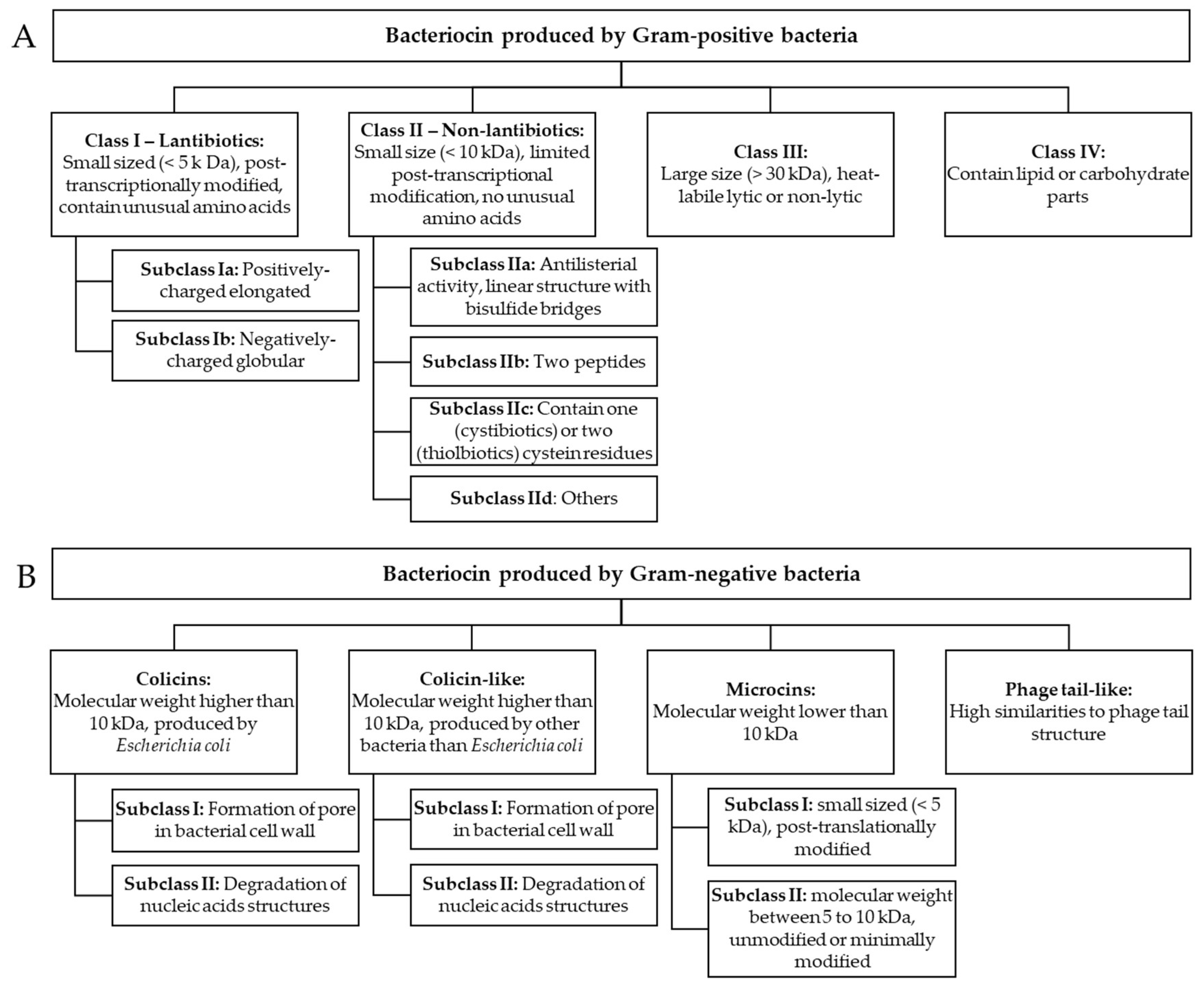

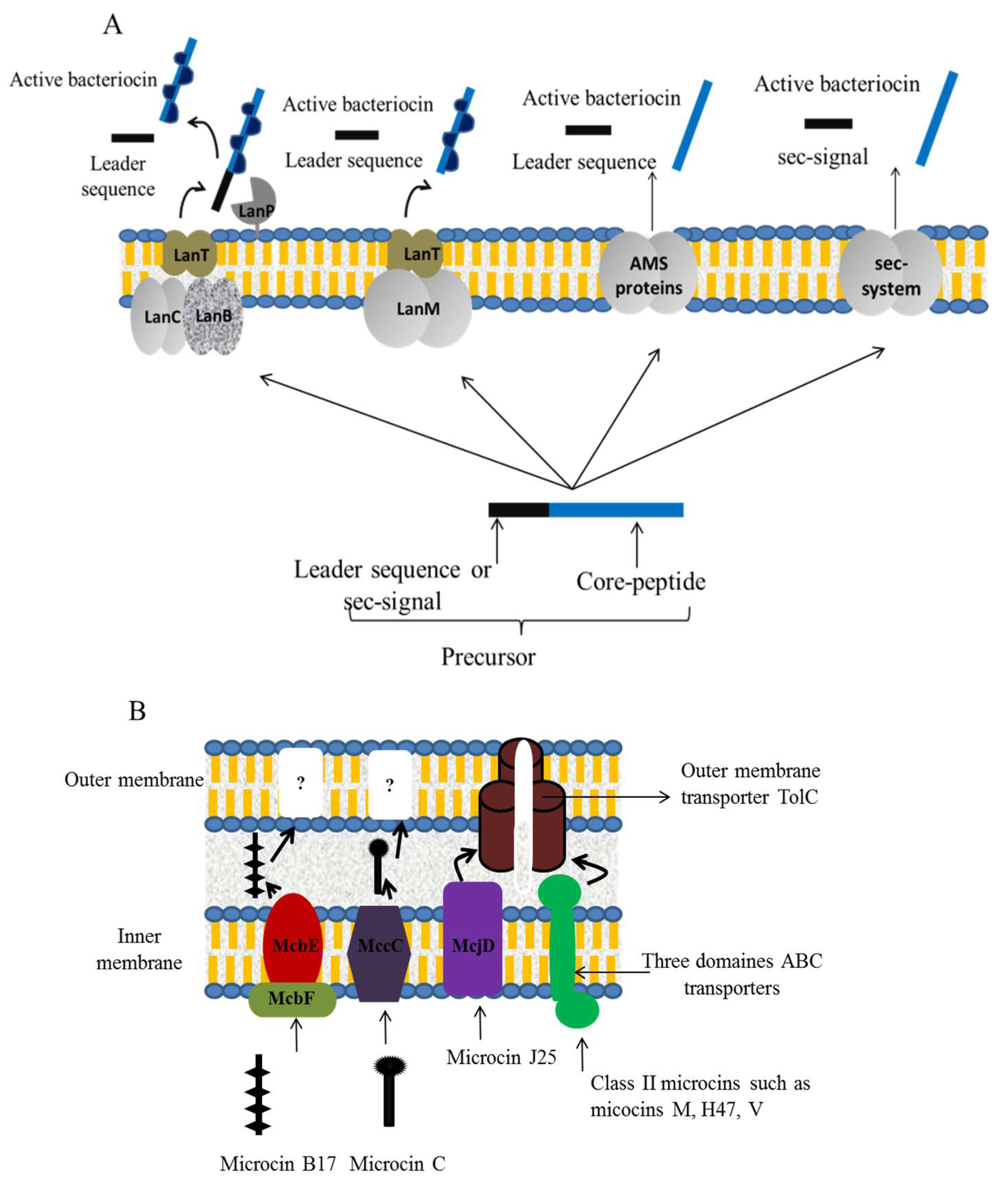
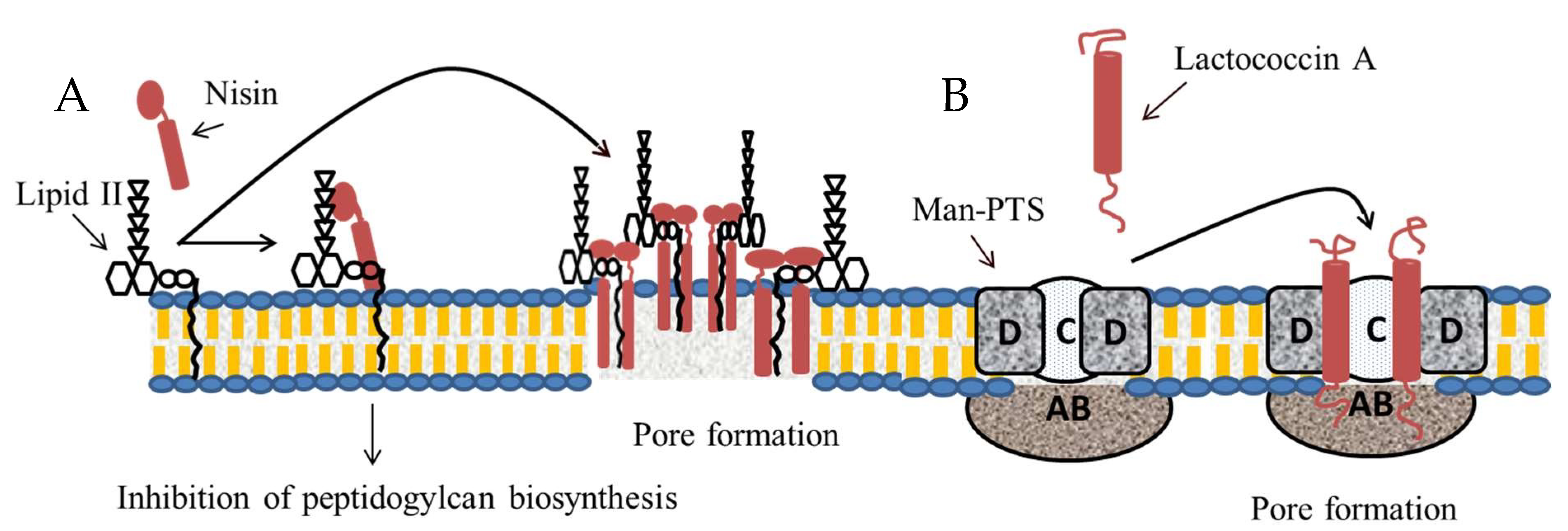
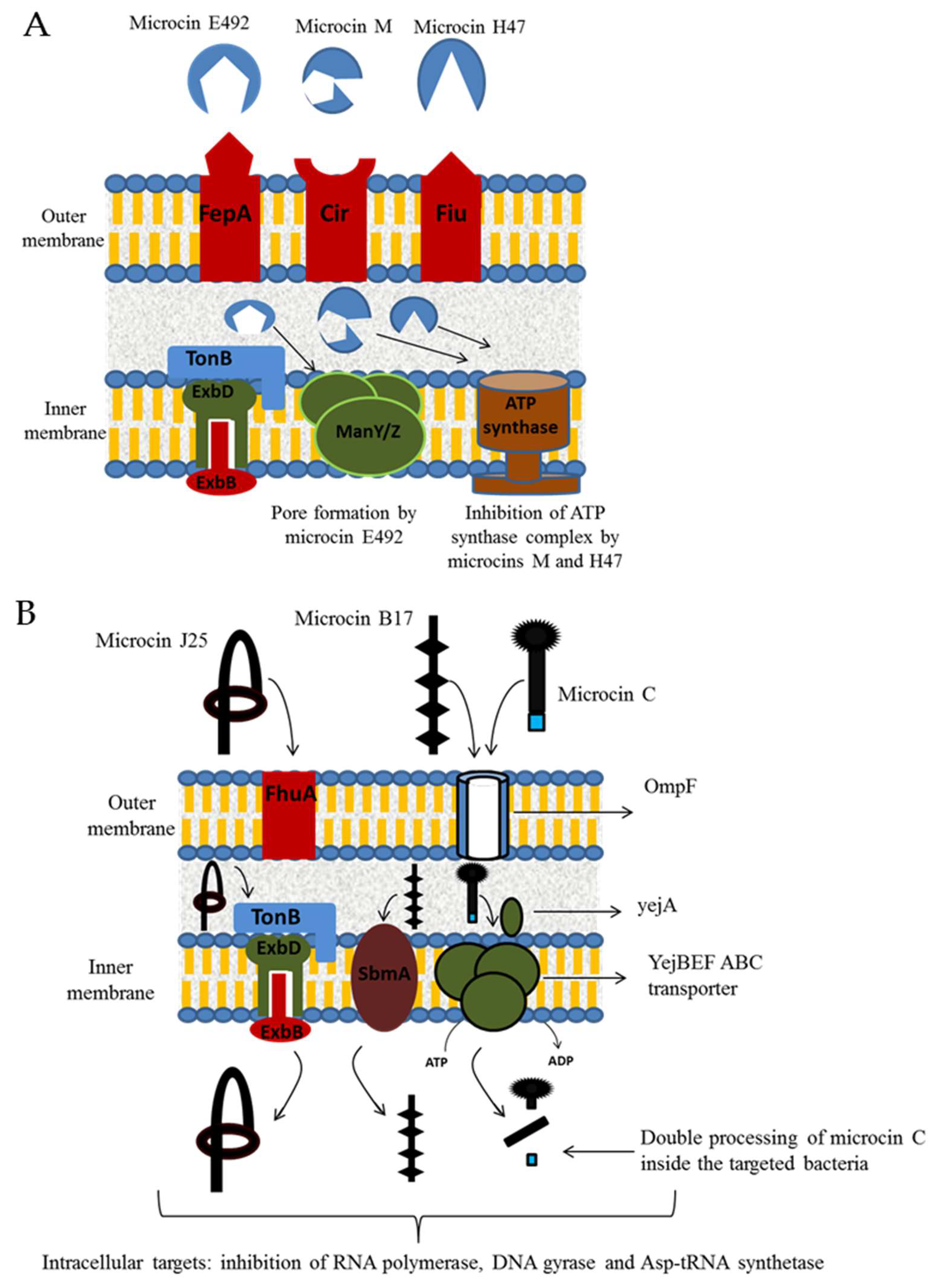
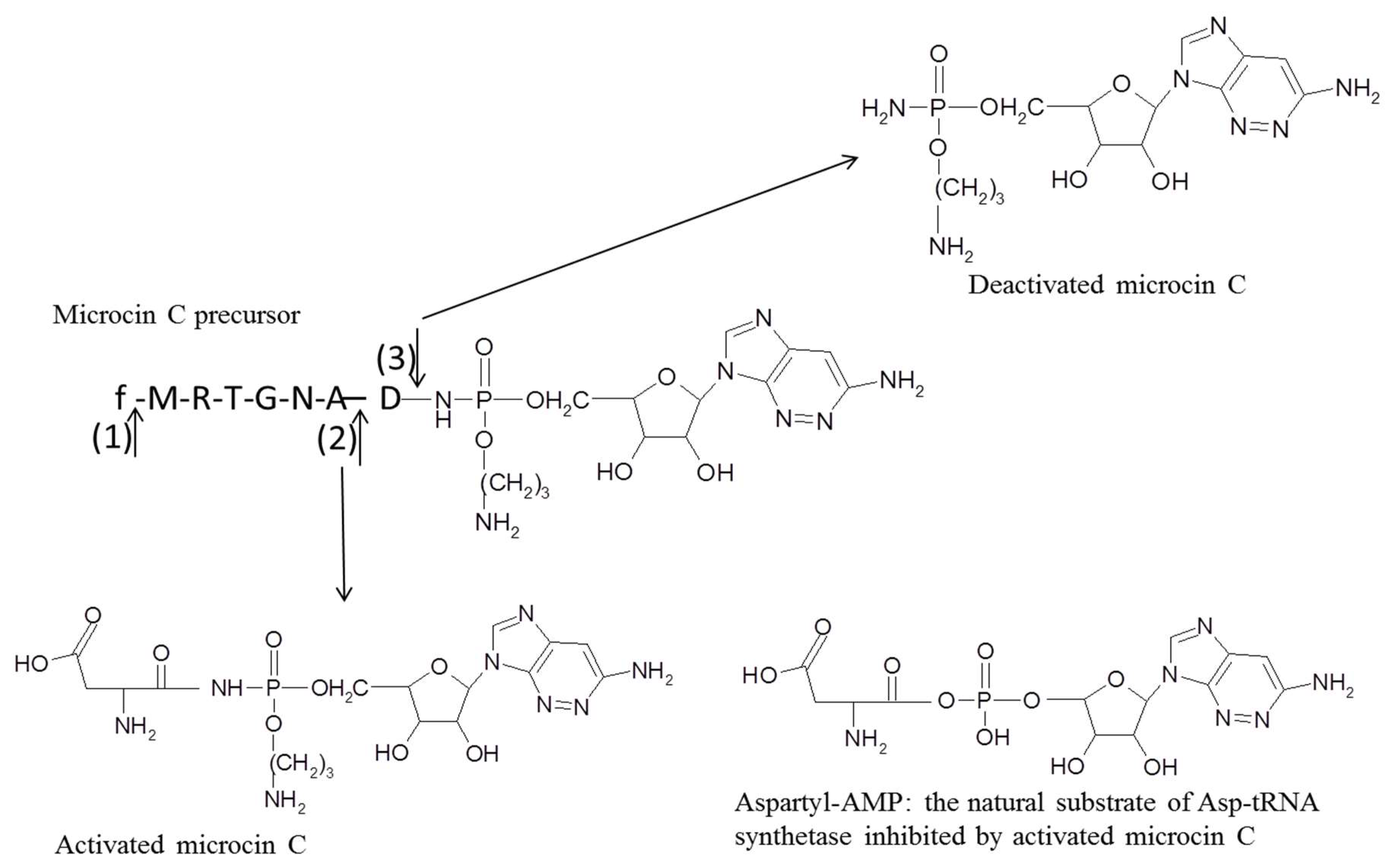
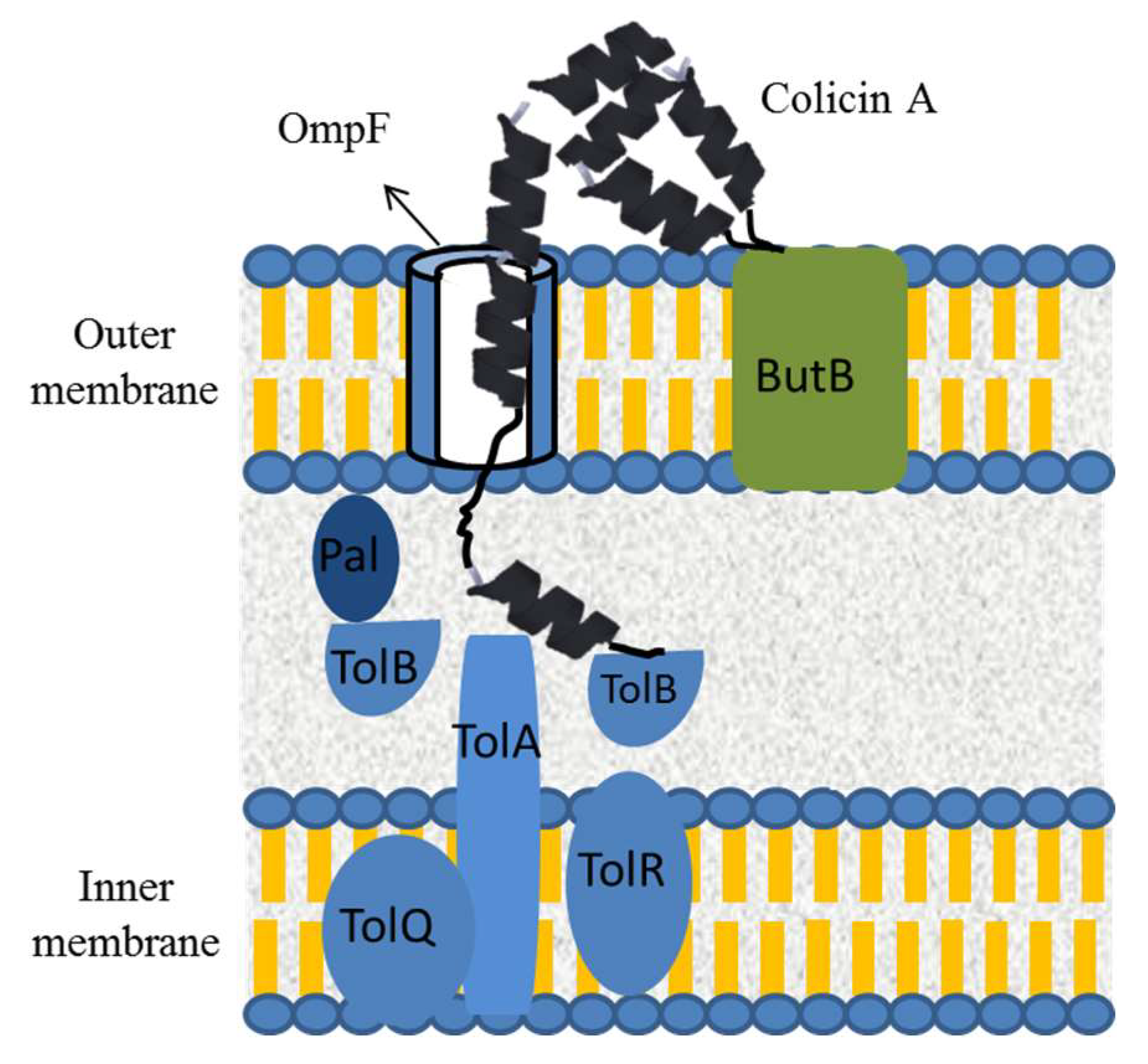
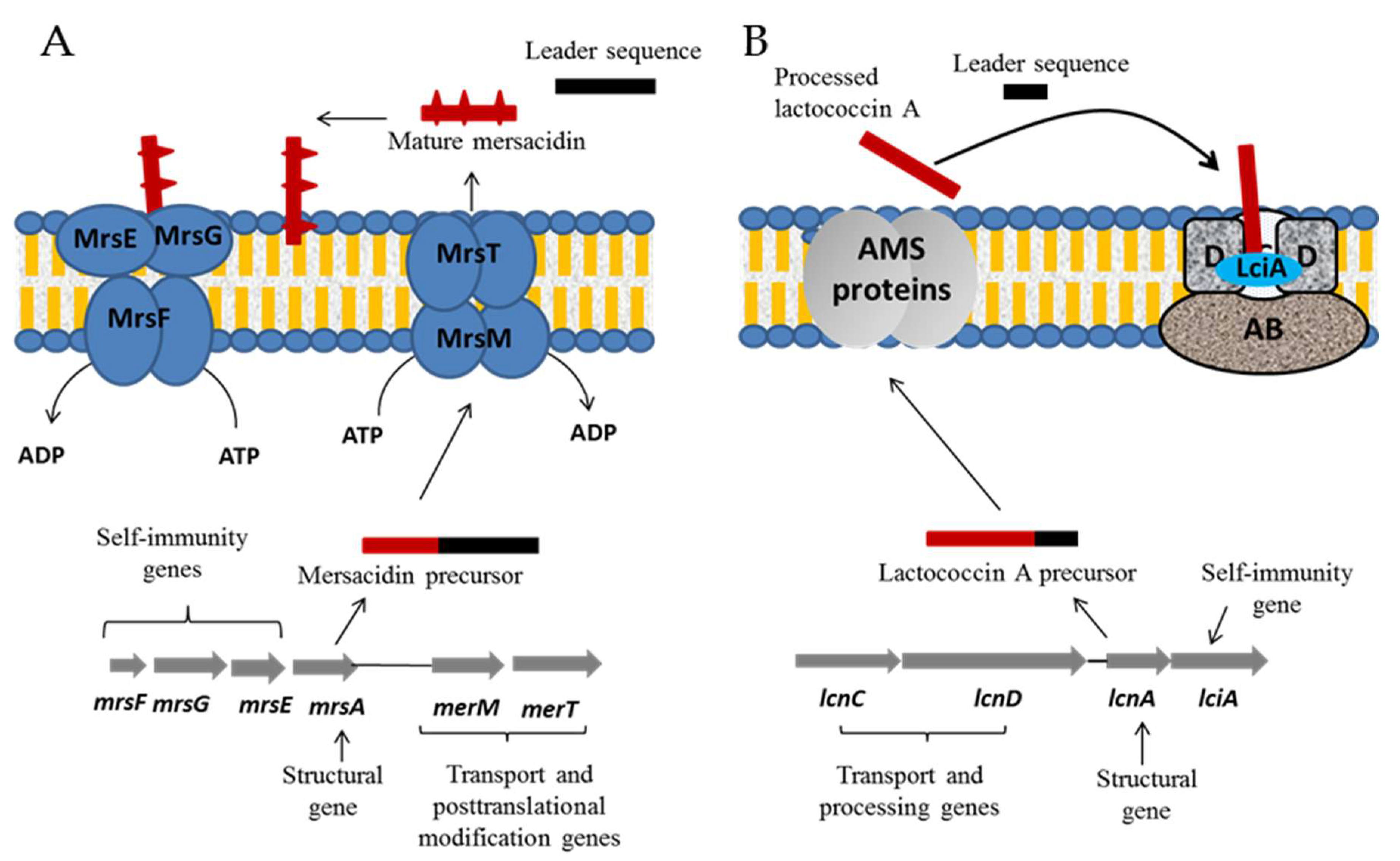
| Bacteriocin | Producer Strain | Sensitive Strains | Antibacterial Activity | Reference | ||
|---|---|---|---|---|---|---|
| MIC (mg/L) | Inhibition Diameter (mm) | |||||
| Bacteriocins produced by GPB | Nisin A | Lactococcus lactis | Methicillin-resistant Staphylococcus aureus (MRSA) | 0.5–4.1 | [124,125] | |
| Vancomycin-intermediate Staphylococcus aureus (VISA) | 2–>8.3 | |||||
| Vancomycin-resistant Enterococcus (VRE) | 2–>8.3 | |||||
| Epidermin | Staphylococcus epidermidis | Staphylococcus aureus | >14 | [126] | ||
| Streptococcus agalactiae | >14 | |||||
| Gallidermin | Staphylococcus gallinarum | Staphylococcus aureus | 4–8 | [127] | ||
| Streptococcus epidermidis | 4–8 | |||||
| Nukacin ISK-1 | Staphylococcus warneri | MRSA | 10–20 | [124] | ||
| MRSE | 10–20 | |||||
| Mersacidin | Bacillus sp. | MRSA | 1–32 | [128,129] | ||
| Streptococcus pyogenes | 0.5–8 | |||||
| Streptococcus agalactiae | 1–8 | |||||
| Streptococcus pneumoniae | 1–4 | |||||
| Subpeptin JM4-B | Bacillus subtilis | Staphylococcus aureus | 15 | [130] | ||
| Streptococcus faecalis | 25 | |||||
| Salmonella sp. | 22 | |||||
| Shigella flexneri | 15 | |||||
| Subtilosin A | Bacillus subtilis | Enterococcus faecalis | 3.125 | [131] | ||
| Listeria monocytogenes | 12.5 | |||||
| Sublancin | Bacillus subtilis | Staphylococcus aureus | 4.36 | [132] | ||
| Bovicin HC5 | Streptococcus bovis | Listeria monocytogenes | >16 | [133] | ||
| Microbisporicin | Microbispora corallina | MRSA | ≤0.13 | [84] | ||
| VISA | ≤0.13 | |||||
| VRE | 0.5–2 | |||||
| Streptococcus pyogenes | ≤0.13 | |||||
| Streptococcus pneumoniae | ≤0.13 | |||||
| Clostridium spp. | ≤0.125 | |||||
| Neisseria meningitidis | 0.5 | |||||
| Neisseria gonorrhoeae | 0.25 | |||||
| Bottromycin A2 | Streptomycesbottropensis | MRSA | 1 | [134] | ||
| VRE | 0.5 | |||||
| Lysostaphin | Staphylococcus simulans | MRSA | 0.007–0.125 | [135] | ||
| Pediocin PA-1 | Pediococcus acidilactici | Listeria monocytogenes | 0.0013–0.0062 | [136] | ||
| Curvacin A | Lactobacillus curvatus | Listeria monocytogenes | 0.28–0.69 | [136] | ||
| Sakacin P | Lactobacillus sake | Listeria monocytogenes | 0.0034–0.0083 | [136] | ||
| Enterocin A | Enterococcus faecium | Listeria monocytogenes | 0.0002–0.0011 | [136] | ||
| Enterocin E 50-52 | Enterococcus faecium | Staphylococcus aureus | 0.2–0.8 | [137] | ||
| Yersinia enterocolitica | 0.156–1.25 | |||||
| Campylobacter jejuni | 0.025–6.4 | |||||
| Enterpco, E-760 | Enterococcus sp. | Salmonella enterica | 0.2–0.4 | |||
| Escherichia coli | 0.1–1.6 | |||||
| Yersinia spp. | 0.1–3.2 | |||||
| Campylobacter spp. | 0.05–1.6 | |||||
| Staphylococcus spp. | 1.6 | |||||
| Listeria monocytogenes | 0.1 | |||||
| Lactocyclicin Q | Lactococcus sp. | Enterococcus faecium | 0.71 | [138] | ||
| Enterococcus faecalis | 0.26 | |||||
| Enterococcus durans | 0.71 | |||||
| Enterococcus hirae | 0.71 | |||||
| Listeria monocytogenes | 1.03 | |||||
| Lacticin Q | Lactococcus lactis | MRSA | 5 | [124] | ||
| Lariatin A | Rhodococcus iostii | Mycobacterium smegmatis | 3.13 | [139] | ||
| Lariatin B | Rhodococcus iostii | Mycobacterium smegmatis | 6.25 | [139] | ||
| Mycobacterium tuberculosis | 0.39 | |||||
| Lacticin 3147 | Lactococcus lactis | MRSA | 1.9–15.4 | [125,140] | ||
| VRE | 1.9–7.7 | |||||
| Mycobacterium tuberculosis | 7.5 | |||||
| Mycobacterium kansasii | 60 | |||||
| Mycobacterium avium | 15 | |||||
| Lactocin MXJ 32A | Lactobacillus coryniformis | Staphylococcus aureus | 10 | [141] | ||
| Escherichia coli | 10 | |||||
| BMP11 | Lactobacillus crustorum | Staphylococcus aureus | 0.3–0.6 | [142] | ||
| Listeria monocytogenes | 0.6 | |||||
| Escherichia coli | 2.4 | |||||
| Salmonella sp. | 0.6 | |||||
| L-1077 | Lactobacillus salivarius | Salmonella spp. | 0.19–0.38 | [143] | ||
| Escherichia coli | 0.19 | |||||
| Yersinia enterocolitica | 0.76 | |||||
| Klebsiella pneumoniae | 0.76 | |||||
| Staphylococcus aureus | 0.76 | |||||
| Pseudomonas aeruginosa | 0.38 | |||||
| Listeria monocytogenes | 0.19 | |||||
| Campylobacter jejuni | 0.09 | |||||
| Microbisporicin NAI-107 | Microbispora sp. | MRSA | 0.06–0.125 | [144] | ||
| VRE | 0.5–1 | |||||
| Penicillin-intermediate Streptococcus pneumoniae (PISP) | 0.015 | |||||
| Mutacin B-Ny266 | Streptococcus mutans | MRSA | 2 | [145] | ||
| VRE (Enterococcus faecalis) | 2.7 | |||||
| Escherichia coli | 1.7 | |||||
| KT11 | Enterococcus faecalis | MRSE | 20 | [146] | ||
| Methicillin-vancomycin-resistant Staphylococcus warneri | 20 | |||||
| VRE | 17 | |||||
| Thiazomycin | Amycolatopsis fastidiosa | MRSA | 0.02–0.1 | [147] | ||
| VRE | 0.004–0.1 | |||||
| Streptococcus spp. | 0.004–0.03 | |||||
| Philipimycin | Actinoplanes philippinensis | MRSA | 0.125 | [148] | ||
| VRE (Enterococcus faecium) | 0.03 | |||||
| Paracaseicin A | Lactobacillus paracasei | Escherichia coli | 18–22 | [149] | ||
| Klebsiella pneumoniae | 16–18 | |||||
| MRSA | 16–20 | |||||
| PJ4 | Lacobacillus helveticus | Escherichia coli | 27 ± 0.45 | [150] | ||
| Pseudomonas aeruginosa | 17 ± 0.35 | |||||
| Staphylococcus aureus | 25 ± 0.32 | |||||
| Enterococcus faecalis | 28 ± 0.18 | |||||
| Enterococcus faecium | 28 ± 0.30 | |||||
| Klebsiella pneumoniae | 21 ± 0.27 | |||||
| Salmonella Typhimurium | 17 ± 0.15 | |||||
| Shigella flexneri | 18 ± 0.16 | |||||
| VJ13 | Pediococcus pentosaceus | Listeria monocytogenes | 27 ± 3 | [151] | ||
| Staphylococcus aureus | 22 ± 2 | |||||
| Bacillus cereus | 22 ± 3 | |||||
| Klebsiella pneumoniae | 20 ± 3 | |||||
| Clostridium sporogenes | 18 ± 3 | |||||
| Citrobacter freundii | 18 ± 2 | |||||
| Proteus vulgaris | 17 ± 3 | |||||
| Clostridium perfringens | 16 ± 3 | |||||
| Streptococcus pyogenes | 16 ± 4 | |||||
| Vibrio parahemolyticus | 16 ± 2 | |||||
| Pseudomonas aureginosa | 15 ± 3 | |||||
| Staphylococcus epidermidis | 15 ± 2 | |||||
| Mycobacterium smegmatis | 14 ± 4 | |||||
| Escherichia coli | 13 ± 2 | |||||
| Bacteriocins produced by GNB | Microcin L | Escherichia coli | Escherichia coli | 12–18 | [152] | |
| Salmonella enterica | 12–18 | |||||
| Shigella spp. | 12–18 | |||||
| Pseudomonas aeruginosa | 8–12 | |||||
| Microcin J25 | Escherichia coli | Escherichia coli | 10.6 | [153] | ||
| Salmonella enterica | 3.2–4.25 | |||||
| Microcin E492 | Klebsiella pneumoniae | Escherichia coli | 2.37 | [154] | ||
| Salmonella enteritidis | 9.86 | |||||
© 2020 by the authors. Licensee MDPI, Basel, Switzerland. This article is an open access article distributed under the terms and conditions of the Creative Commons Attribution (CC BY) license (http://creativecommons.org/licenses/by/4.0/).
Share and Cite
Simons, A.; Alhanout, K.; Duval, R.E. Bacteriocins, Antimicrobial Peptides from Bacterial Origin: Overview of Their Biology and Their Impact against Multidrug-Resistant Bacteria. Microorganisms 2020, 8, 639. https://doi.org/10.3390/microorganisms8050639
Simons A, Alhanout K, Duval RE. Bacteriocins, Antimicrobial Peptides from Bacterial Origin: Overview of Their Biology and Their Impact against Multidrug-Resistant Bacteria. Microorganisms. 2020; 8(5):639. https://doi.org/10.3390/microorganisms8050639
Chicago/Turabian StyleSimons, Alexis, Kamel Alhanout, and Raphaël E. Duval. 2020. "Bacteriocins, Antimicrobial Peptides from Bacterial Origin: Overview of Their Biology and Their Impact against Multidrug-Resistant Bacteria" Microorganisms 8, no. 5: 639. https://doi.org/10.3390/microorganisms8050639
APA StyleSimons, A., Alhanout, K., & Duval, R. E. (2020). Bacteriocins, Antimicrobial Peptides from Bacterial Origin: Overview of Their Biology and Their Impact against Multidrug-Resistant Bacteria. Microorganisms, 8(5), 639. https://doi.org/10.3390/microorganisms8050639






